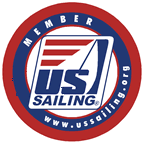During a recent SYSCO (Small Yacht Sailing Club of Oregon) Series, a protest regarding life jackets was submitted and subsequently withdrawn. While no official decision was made with respect to the protest, the protest committee worked through the issue in an effort to provide clarity for competitors in the future. Our findings have resulted in some minor changes to the OCSA (Oregon Corinthian Sailing Association) General Sailing Instructions; competitors are encouraged to review those instructions, changes and associated documents.
SUMMARY—When the RC (race committee) flies the “Y” flag, requiring all competitors to wear a PFD (personal flotation device), a “belt pack” type PFD is not acceptable.
We sail under several sets of rules; one of which are the PIYA (Pacific International Yachting Association) safety regulations. Their updated classification, “Nearshore”, states:
“Each crewmember shall have alternatively; a Coast Guard approved Type III or Type V life jacket/National Safety Authority of the OA (organizing authority) approved equivalent that is intended for small boat sailing or other active boating for each crewmember or an inflatable life jacket as described above in 3.1.1.”
An inflatable life jacket must meet the requirements of 3.1.1, which states:
“Each crewmember shall have a life jacket that provides at least 33.7lbs (150N) of buoyancy, intended to be worn over the shoulders (no belt pack), meeting either Coast Guard/National Safety Authority of the OA or ISO specifications.”
Therefore, an inflatable life jacket must provide at least 33.7lbs of buoyancy, must be worn over the shoulders, and must be Coast Guard approved. Inflatable life jackets of a “belt pack” design are specifically prohibited.
DISCUSSION—A protest arose during an event with particularly strong breeze and after the RC displayed flag “Y” which is defined as “Wear a personal flotation device.” The specific rule by which the RC can display flag “Y” is Rule 27.1 which states:
“No later than the warning signal, the race committee shall signal or otherwise designate the course to be sailed if the sailing instructions have not stated the course, and it may replace one course signal with another and signal that wearing personal flotation devices is required (display flag Y with one sound).”
While all of this seems quite straight forward, the question as to what, exactly, qualifies or constitutes a “personal flotation device” (PFD) became the issue that the protest committee had to answer. The first place we turn to is the OCSA General Sailing Instruction (GSI) which states:
“1. RULES: Races shall be governed by the current ISAF Racing Rules of Sailing (RRS), the prescriptions of US Sailing, the rules of any one-design, level, or PHRF fleet participating in the event, PIYA Category Equipment Requirements (where specified), and these OCSA General Sailing Instructions; the Notice of Race and the Supplemental Sailing Instructions for the event will apply.”
This identifies the “PIYA Category Equipment Requirements (where specified)” to be in effect. As we continue through the OCSA GSI we find the PIYA Requirements specified in 17. SAFETY as:
“17.4) All boats shall comply with PIYA Category IV Special Regulations (See http://www.ussailing.net/piya/)”
Unfortunately, the PIYA Category Regulations have been updated, prompting the subtle changes and updates to the OCSA GSI, and are now referred to as the PIYA Safety Equipment Requirements (SERs). The new classification corresponding to the now retired “Category IV”, is “Nearshore”. Both of these safety requirements represent the lowest threshold of required equipment for competitors and can be seen in their entirety here: http://www.piyasailing.com/sers.pdf
From the PIYA SERs, we find Personal Safety Equipment (specifically PFDs) are addressed in section 3.1 and 3.1.2 reads as:
“Each crewmember shall have alternatively; a Coast Guard approved Type III or Type V life jacket/National Safety Authority of the OA approved equivalent that is intended for small boat sailing or other active boating for each crewmember or an inflatable life jacket as described above in 3.1.1.”
So from this we find that a Coast Guard approved Type III or Type V life jacket satisfies the rule, but if it is an inflatable life jacket it must meet the requirements of 3.1.1 which states:
“Each crewmember shall have a life jacket that provides at least 33.7lbs (150N) of buoyancy, intended to be worn over the shoulders (no belt pack), meeting either Coast Guard/National Safety Authority of the OA or ISO specifications.”
Therefore, an inflatable life jacket must provide at least 33.7lbs of buoyancy and must be worn over the shoulders and must be Coast Guard approved, and inflatable life jackets of a “belt pack” design are specifically prohibited.
So, when the RC correctly signals “Y” per RRS 27.1, the minimum required “personal flotation device” is either
- A USCG approved type III or V of foam/fixed buoyancy construction, or
- An inflatable that is worn over the shoulders and is regularly checked for air retention and provides 33.7 lbs of buoyancy and is USCG approved.
Further, when “Y” is not in effect, the PIYA safety equipment regulations can not be satisfied with a “belt pack” type PFD and each crewmember must have a life jacket meeting PIYA SER 3.1.2 although it need not be worn and the competitor may choose to wear a non-approved or non-compliant flotation device.
An added note is that to meet USCG type III/V approval the tag stating such must be present and visible. Worn, damaged or removed certification tags will not satisfy the requirement, and specifically there are several common and very comfortable “dinghy style” vests in widespread use that are not USCG approved and do not, therefore, satisfy the rules. Bottom line, make sure that you have a USCG approved PFD available for each of your crew (which isn’t just a rule, it’s the law) and if “Y” is flown they must be worn.
Eric Rimkus
US Sailing Judge, Area L
Craig Daniels
US Sailing Judge, Area L



